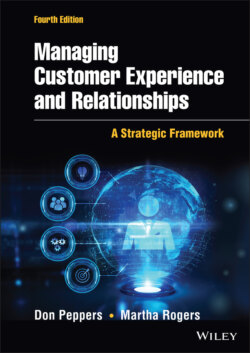Читать книгу Managing Customer Experience and Relationships - Don Peppers - Страница 45
Don't Run Your Business on the Goldfish Principle
ОглавлениеCertain species of tropical fish have no territorial memory. None. Perhaps this trait evolved because the species inhabited the open sea, where territory was not very important and territorial memory counted for nothing, but the fact is that no matter where such a fish swims today, it never recognizes the fact it has swum there before. We can imagine such a fish swimming around and around in an aquarium or a goldfish bowl and never getting bored, because there's always something new and interesting to see.
Many of today's businesses still operate on “the Goldfish Principle” when it comes to their customers. They evolved in the age of mass marketing, before computers made it possible to remember customers individually, so whatever business model they developed didn't rely on remembering an individual customer from transaction to transaction. For instance, we can recognize a company operating on the Goldfish Principle when we sign up for a promotion with our airline or car rental firm, but then we continue to get email blasts urging us to sign up. Another example is when we go online to our credit card website and schedule our payment a few days before the due date, but then they still send us an email reminder that our payment is almost due.
Sometimes when a company is operating on the Goldfish Principle the results can actually be funny. For instance, below is a copy of an email message that a colleague of ours received from Marriott Rewards, with a comically irrelevant message. They might as well be broadcasting a message to the customer saying, “We don't care who you are!”
EXHIBIT 3.3 The Goldfish Principle in Action
With today's information technology there's absolutely no excuse for operating on the Goldfish Principle. It's actually worse than doing nothing, because it demonstrates a level of incompetence that destroys a customer's trust in the business.
Operating on the Goldfish Principle today doesn't just communicate that you aren't competent enough to run a sound business, it screams that you don't care enough about your customers to even try to be competent.
Relevance in a customer experience can only be delivered by an enterprise that is trying to see the problem through the customer's own eyes. In effect, we could say that delivering a truly relevant customer experience requires an enterprise to have empathy for the customer, “feeling the customer's pain,” so to speak. And this leads to the second element in customer competence: trustability.9 A trustable customer experience is delivered when the enterprise proactively acts in the customer's interest as it attempts to deal with what the customer experiences, even when there is a cost to the business itself.
Of course, trust has always been important in commerce and it is still essential to any company's economic success. Few companies will prosper long if they cheat their customers, or steal from them, or deceive them. But in today's hyper-interactive world, mere trustworthiness—that is, doing what one says one is going to do and not violating the law—is no longer sufficient to render a truly frictionless customer experience. As the velocity and volume of interactions have increased, customers have come to expect more from the businesses they deal with. Today they expect an enterprise to be proactively trustworthy, or trustable. A trustable enterprise provides complete, accurate, and objective information, and helps the customer avoid mistakes or oversights. If a customer feels they have to count their change or double-check that they aren't doing something they're going to regret later, this is one more type of friction to be avoided in a streamlined customer experience.
A few good markers of a trustable customer experience would include:
Facilitating objective customer reviews
Reminding a customer that the warranty period is nearly up
Reminding a customer that a subscription renewal is imminent
Advising a customer that they might be buying more of a product than they need
Providing a refund when one is due, without waiting for the customer to have to request it
At its core, trustability requires having genuine, human empathy for customers, and then applying the principle of reciprocity, treating each customer the way you would want to be treated if you were that customer. We could think of relevance as knowing who the customer is and meeting their individual needs, while trustability ensures that what the individual customer needs is provided without hassles, misinformation, tricks, bias, or any other motive that might not accord with the customer's true interest. In other words, relevance is seeing what the customer sees, while trustability is experiencing what the customer experiences.
